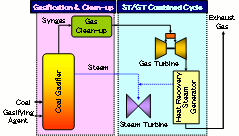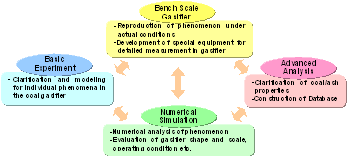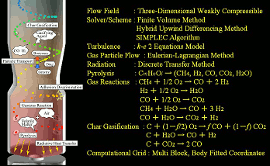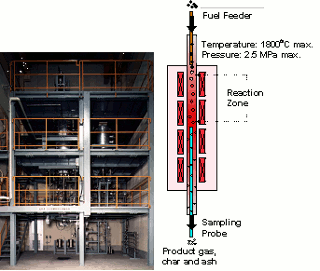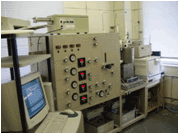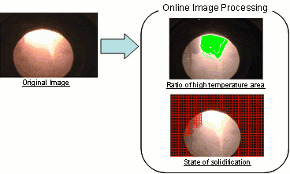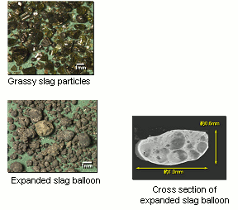|
Coal is widely distributed & abundantly reserved, so it's possible to ensure the stable supply. However, CO2 emission from coal is larger than from other fossil fuels. There's a pressing need to develop the Integrated coal Gasification Combined Cycle (IGCC) plant which is high efficiency & eco-friendly. CRIEPI are developing the coal gasification technology which is key technology of IGCC. |
< Basic Flow Diagram of IGCC system > IGCC system is integrating coal gasification with combined cycle power generation system. In IGCC system, coal is gasified in a gasifier to produce synthetic fuel gas. The fuel gas is burned to operate a gas turbine. Then, high temperature exhaust gas from the gas turbine is sent into the boiler to produce steam that is used to operate a steam turbine. |
|
Japan has been working on development of a unique air blown IGCC technology. After experiencing the 200t/d pilot plant project successfully, Japanese government and all Japanese electric power companies decided to construct the IGCC demonstration plant using the air-blown gasifier, and Clean Coal Power R&D Co., Ltd. was established in June, 2001 to conduct the demonstration project. The output of the demonstration plant is 250MW, and the capacity of the gasifier is 1,700t/d. The target net thermal efficiency of the demonstration plant is 40.5% (HHV basis). The operation has started in September, 2007. |
< Concept of Air-blown Two-stage Entrained Flow Gasifier > The pulverized coal is pneumatically transported to the combustor and the reductor. The char contained in the product gas is collected and then recycled to the combustor. The gasifying agent (air) is fed into the combustor to burn the pulverized coal and the recycled char at high temperature, so that the coal ash was discharged from combustor as molten slag. |
|
CRIEPI and Mitsubishi Heavy Industries Co., Ltd. set up the bench scale gasifier (2t/d coal gasifier) in 1983 and have developed a prototype of the air blown pressurized two-stage entrained flow gasifier with dry coal feed system. Recent years, in order to support the IGCC demonstration plant project, our institute is developing the evaluation tools to optimize the design and operation of the coal gasifier. Our tools integrate the experimental technique with the numerical analysis technology for the securing of reliability, the achievement of highly efficiency and the cost reduction. The numerical simulation approach is one of the most effective methods understanding the phenomena in the coal gasifier in order to optimize the design and operation of the gasifier. CRIEPI developed three dimensional numerical analysis technology for predicting gasification performance of the gasifier. To consider a variety of phenomena such as the gas flow, the particle transport, the heat transfer, and chemical reactions, a lot of analytical models based on the experimental results have been introduced in our numerical analysis technology. |
< Evaluation Tool for Design and Operation of Gasifier >
< Outline of Numerical Simulation Technology > The phenomena in coal gasifier can be predicted by adding the coal gasification models (pyrolytic reaction, char reaction and gas phase reaction) to the 3D simulation method of particle-gas two-phase flow. |
|
Modeling the gasification reaction is one of the important research items to clarify the phenomenon in coal gasifier. For instance, optimization of design, prediction of performance and evaluation of coal type. In IGCC, gasifier is operated under pressurized condition, about 2.5-3MPa, and the gasification temperature becomes the high temperature of 1500 degree C or more. Then, CRIEPI developed Pressurized Drop Tube Furnace (PDTF) with the specification of the max. 1800 degree C and max. 2.5MPa, and is conducting the experiment and the modeling of the coal pyrolysis and the char gasification reaction under the high temperature and pressurized conditions. Using this PDTF and pressurized thermo gravimeter (PTG), it is possible to obtain reaction rate in wide range of reaction temperature. |
< Pressurized Drop Tube Furnace > |
|
< Pressurized Thermo Gravimeter > |
There are two major gasification reaction in the gasifier. C+CO2→2CO, C+H2O→CO+H2 PDTF and PTG are equipments to measure these reaction rate, and two equipments are used properly according to the reaction condition, and it experiments efficiently. The reaction model is constructed with a detailed experimental results that imitates the condition in the actual gasifier. Then, these results are reflected in the numerical simulation technology. |
|
Now, we are researching by 3 t/d new coal gasifier as a bench scale gasifier that replaces 2 t/d gasifier. A new facility is gasifier for the basic research that has a lot of feature and special measurement equipments. So, it is possible to achieve the wide range of gasification condition and quantitative evaluation of the phenomenon in gasifier. Using 3 t/d gasifier, the influence of gasifier operating condition and the gasification characteristic of the various types of coal are evaluated. In addition, new monitoring & measuring technology and utilization technology of coal gasification slag are developed. |
< Outline of 3 t/d Coal Gasifier > Coal capacity is 3 t/d and operating pressure is 2 MPa. Not only air but also oxygen can be used as a gasifying agent, and a wide gasification condition can be examined. |
|
< Monitoring System for Slag Flow > We are developing a new monitoring system for slag flow. In this system, the image of the slag flow in the gasifier bottom is analyze, and the flowing situation is evaluated. |
< Slag Utilization Technology > Coal ash is melted in gasifier, then melted ash is quenched by water. So, coal ash is discharged as grassy slag particles. Using characteristic that slag particle expand by heating, It is researched to use the expanded slag for the light-weight aggregate and the greening materials, etc. |


